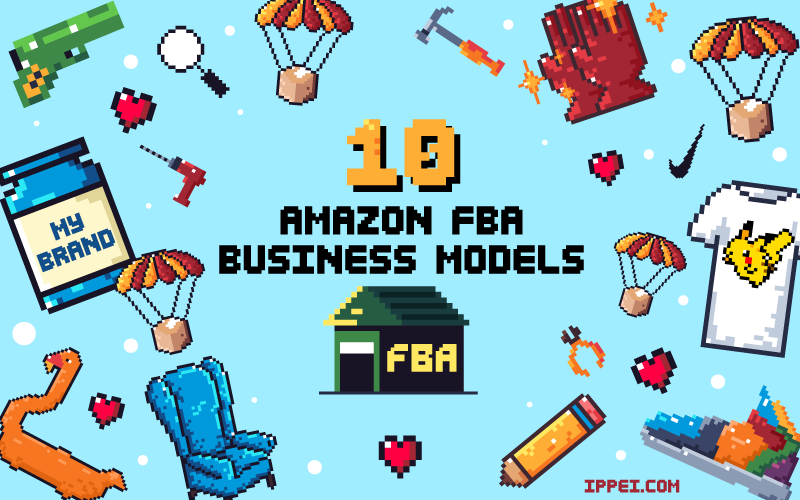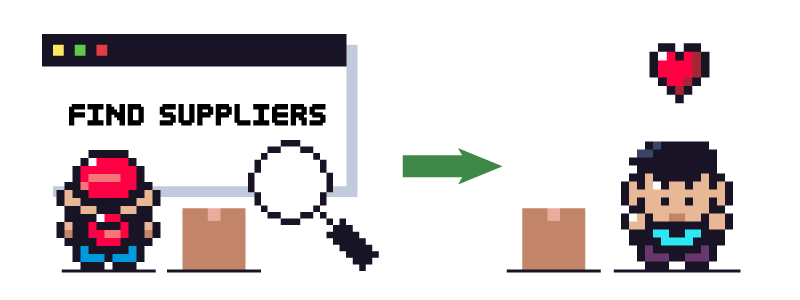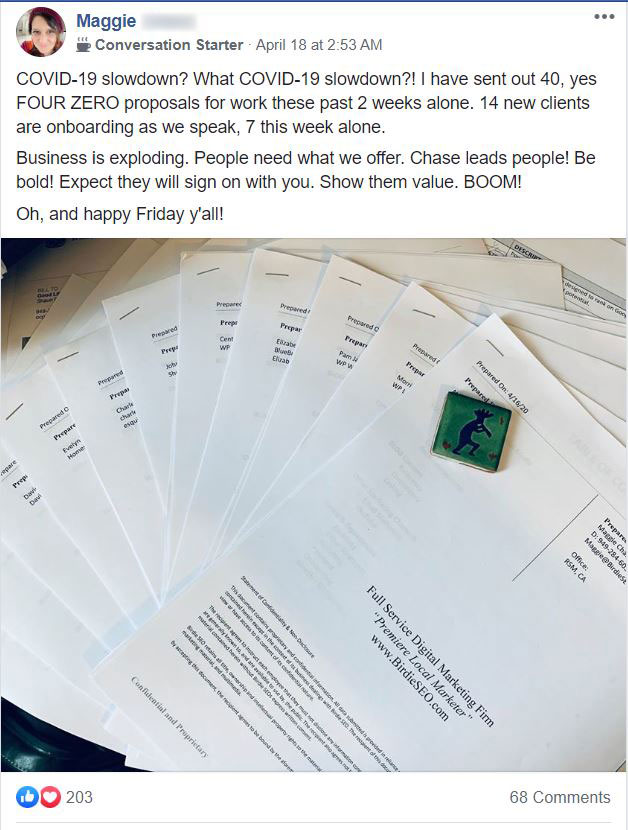
Research Amazon FBA business models before you start. After all, there are many ways of making money on Amazon. Learning each strategy will help you choose the best business model for your lifestyle and resources.
1. Wholesale
In this model, sellers purchase branded products in bulk at wholesale prices directly from suppliers. They sell it as individual units on Amazon for a higher price. These are brands that customers are already looking for, so simply offer the best price and you'll get sales without marketing.
According to JungleScout, 47% of sellers spend less than $2500 to get started in this business model. 47% of wholesale sellers are in the home and kitchen space. 32% sell toys and games.
From our experience, sellers at minimum should have $5000+ because larger bulk orders come with bigger discounts.
The catch is that you need access to special vendors and negotiate deals that get you prices that competitors don't have. This requires a lot of contacts by putting yourself out there.
Pros
Cons
Who is Wholesale Amazon FBA For?
Sellers with money. Those with the capability of putting up a large initial investment might do well at wholesale. You need to have this initial investment, and the means to survive without profit for months.
A numbers person. People who are good with numbers do well. It is essential that sellers can follow the numbers and wholesale process. People that don't want to mess with all the creative things required to build brands & innovate products.
The researcher. It also helps if you have experience in product and market research.
The People's Person. The biggest key in wholesale is to build connections with suppliers & distributors that have the best prices and foster those relationships overtime. Going to trade shows or cold calling / emailing, you cannot be afraid of rejection. Wine & dining your suppliers is part of it. Having exclusive accounts with those suppliers is the lifeline of this business model.
2. Retail Arbitrage
Retail arbitrage involves finding low-cost products in physical, brick-and-mortar stores and selling them on Amazon at a higher cost. You must go into stores, sift through clearance, pack, ship, and track purchases without invoices.
This model can be done with Amazon FBA, where sellers ship the product to Amazon for distribution, or Amazon FBM, where sellers ship directly to their customers.
Retail arbitrage is also a way for sellers to benefit from panic buying and products in outrageous demand.
Pros
Cons
Who is Retail Arbitrage For?
Those on a budget. Spend whatever you want and get a lot of more back. According to JungleScout's survey, 49% of retail arbitrage sellers spend less than $1,000 getting started. A third of sellers started with less than $500.
The beginner. This is a low-cost way to learn the Amazon system. It’s a great way to get started and learn without an enormous investment on the line.
Someone with a personal vehicle. You need to drive to physical locations.
Those who don’t already have a full-time job. This takes a lot of time. To succeed, you won’t be able to manage a full-time job on top of everything involved.3. Online Arbitrage

Online arbitrage is just like retail arbitrage, though you order product online instead of in stores.. The product is resold at a higher cost on Amazon. This is the next logical step from retail arbitrage towards a wholesale business.
Pros
Cons
Who is Online Arbitrage For?
The beginner, who is ready for the next step. Like retail arbitrage, it’s easy to get your feet wet with online arbitrage.
The person who wants to learn, but doesn’t have a vehicle.
Someone ready to put up a slightly higher investment. Perhaps you made a bit of money on retail arbitrage. Use that to invest in an online haul next.4. Liquidations

Liquidations is very similar to both kinds of arbitrage. But, instead of hunting for clearance or low-cost products, you hunt for bulk liquidations of multiple items. You can do this at physical locations, or websites like 888lots or Bulq.
This is not a short term business. But, it gives the seller a chance of turning a small investment into a large amount of money quickly.
Pros
Cons
Who is Liquidations For?
Those who are starting out. This is another way to learn Amazon FBA without a wholesale or private label-sized investment.
Those without a lot of money. You can start with a single order and work up from there.The Simplest Biz course will teach you more.
5. Private Label
Private label sellers source unbranded products from a third party supplier. Then, they brand the products as their own. They sell the newly branded products at a higher price to make a profit.
Many sellers believe private label is dead. Your little brand will compete against the big guys. For example, Amazon Basics and Amazon Essentials are private labels.
Pros
Cons
Who is Private Label For?
Those able to wait for money to come in. 35% received a profit within 6 months of selling.
Those who have a talent for marketing and branding.
People or businesses that already have a following.
6. Passion Product
The passion product FBA model is a variation on the private label business. Instead of buying an established product with no brand, you manufacture your own unique product.
With a passion product, research begins at the heart. Think of what you love. Research how other sellers have met that need. Make a product that’s better. Add functionality and features. And, by choosing something you believe in, you will understand your customers more.
Then, start a product launch group. You will need to crowdfund through a Kickstarter campaign to get the money to launch.
Pros
Cons
Who is Passion Product For?
Someone who needs to be passionate about their product. Other sellers say this can be a big negative. If you love your product too much, you might not see necessary changes. Your product might suck, and you will be stuck.
The social butterfly. A Kickstarter requires that social connection and visible passion. It may even require you to be the face of your brand, which you may not like.
Someone with no cash, but will ask for it. It sounds good to say you don’t need cash upfront to start your passion product. But in reality, you do. It just won’t be your money. You will have to ask for it and then deliver on your promises.7. Amazon Homemade
Amazon Homemade allows you to make your own product- with your own hands- and sell it. In exchange for their services and reputation, Amazon takes a 15% referral fee per sale.
This is one of the least popular ways of making money on Amazon. Also, there is a lengthy application process.
Pros
Cons
Who is Amazon Handmade For?
Established sellers. Actual artisans only. All products must be handmade, hand altered, hand assembled.
Creatives at heart. Consider Handmade if you love the idea of creating a product, but don’t want to get into the world of private labels and big manufacturers.
Those who are scaling their business off of Etsy.
8. Merch by Amazon
Merch by Amazon is an on-demand T-shirt printing service. You create an original design, choose a color, and set a price. Amazon sells your design, and you earn a royalty.
Here are one seller’s profits. She has sold over 12,000 T-shirts and has made $29,595.59 in profit.
To do Merch by Amazon, you must request an invite. This takes you to an application. Prove you will bring established value to Amazon with an established website or portfolio. Amazon will look at this most.
This application can take weeks to get approved, if it does at all. Once approved, you go on a waitlist. Your wait can be up to 6 months before you can even list a single T-shirt.
Pros
Cons
Who is Merch by Amazon For?
Those looking to start an Amazon FBA business with no money.
Established artists and graphic designers.
Those with a large social media following. This can help prove that you will bring value to the platform. (It will also help with sales.)If Handmade is appealing, but you don’t have the time. Merch handles the creation of the physical product, packing, shipping, and more. You reap the benefits.
9. Kindle Direct Publishing
KDP is Amazon’s self publishing platform. Create your book, journal, comic book, or calendar. Upload it to KDP, and sell. Even if you are not an author, you can use KDP for almost any digital product.
From there, you will publish it as an eBook or physical book. You get paid a royalty from your sales. Royalties are different depending on the options you choose and which country you are in.
Pros
Cons
Who is KDP For?
Digital creators and authors.
Those looking for the easiest way to get their feet wet on Amazon. With no barrier of entry, you can use this model to see the backside of Amazon with no risk.
Those who aren’t looking to make the big bucks. You probably won’t make much with KDP, but with good keywords, you can make a little extra cash.
Those with a following. Course creators often write books for KDP to scale their social media presence into another income stream.10. Dropshipping
When you dropship through Amazon, the seller does not keep their own product inventory. Rather, they transfer customers’ orders directly to the manufacturer.
Doing this with Amazon requires a ton of set up. It does remove the seller from much of the typical Amazon FBA hassle with inventory. For more information, start here.
Pros
Cons
How to Make the Most of Your Amazon FBA Business
I wouldn’t recommend scaling your business too quickly. Wait until your operations are flowing. Work through every snag. Once you’re ready, add new strategies one by one. Consider:
Improving the product you sell.
Adding a second, and then third product.
Develop your paid traffic principles to optimize your advertisements.
Build your brand and your following.
Open another store off of Amazon, and sell there.
Once you are worth something, you can consider selling your brand.
Is Amazon FBA still profitable?
Yes you can still profit from Amazon. However, it's definitely more competitive than it was 3-4 years ago. There are more big time distributors and suppliers doing FBA themselves, driving the price down of many product categories.
To be successful today, you need to make sure that you put max effort into every aspect of the business. From the pictures you use on the listing, to branding & packaging, maybe even innovating or bundling products that have not existed before.
The competitive edge you have against the big suppliers is that you can give a lot more attention to detail and go the extra mile.
Read More: Amazon FBA still profitable?
Amazon FBA Alternative Business
Amazon FBA is still a viable business absolutely. New Amazon sellers make an average of $42,000 each year. But, a lot of this success depends on what business model you choose, your situation, and your own strengths and weaknesses. Sometimes, it just gets down to luck.
With enough tenacity, you can always turn a failure into a learning experience, but most people fail Amazon FBA because they quit too early. Most Amazon coaches out there talk about a 2 year learning curve. Where people can expect to face a lot of struggles and maybe not see any profit.
Before you choose which Amazon FBA business model to follow, continue to look into all of your options.
I sold on Amazon FBA for years. I found more consistency in the local lead generation business.


